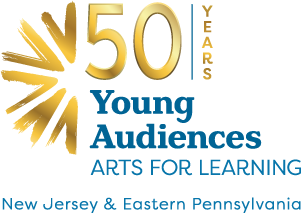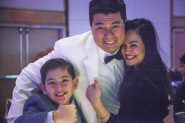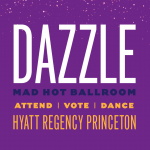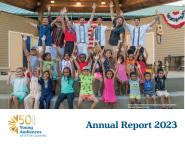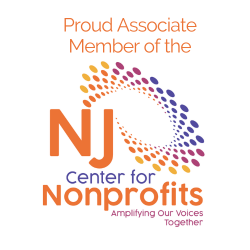Town Topics Newspaper – Young Audiences Brings Feast of Arts To Hundreds of New Jersey Schools

Printed: November 1, 2017
By Donald Gilpin
In school environments characterized by emphasis on testing and sports, tight budgets, increasing competition for college admissions, and diminishing job opportunities, the arts might seem a low priority.
Not so, says Ann Betterton, development director of Young Audiences New Jersey and Eastern Pennsylvania (YA), which worked with more than 350,000 children through more than 4,000 programs in 573 schools in every county in New Jersey last year.
Dance, literary arts, music, theater, visual arts, digital media — every school day of the year, there’s probably at least one YA program taking place somewhere in the state.
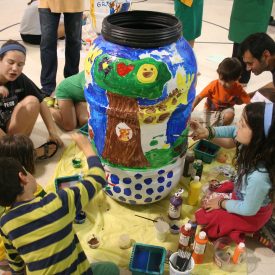
CREATIVELY GREEN: Young Audiences teamed up with Littlebrook School for their Creatively Green Family Arts Festival, bringing together children, parents, educators, and artists to link art making with protecting the environment.
Performances are still a critical component of YA’s work as it celebrates its 45th year, but interaction between artists and children and student participation are always key. More than 50 percent of their programs involve classroom work, residencies, professional development, or teacher workshops. “Any way we can bring arts education to children, we do,” said Marketing and Public Relations Director Denyce Mylson.
“We’re a funny arts agency,” said Betterton. We have no venue. We have no ticket holders, no students who come to our venue to take classes. We have no alumni.”
Despite the challenging conditions in many schools now, YA continues to assert its ambitious, transformative goal “to inspire young people and expand their learning through the arts.” The teaching artists “can be change agents in the schools,” Betterton said.
21st-Century Learners
Continuing to discuss the power of the arts in the broader field of education, she added, “We’re not expecting the kids we work with to become professional artists. That’s not the goal of the work. We want to help schools develop children who are 21st-century learners, who can collaborate, who can see across different subjects, who can do these interesting projects. We envision a world where fields of study are interconnected and the arts play a huge role in helping kids to make those connections.”
Emphasizing the importance of “problem-solving, trial and error, and experimentation,” Betterton noted, “so much of that doesn’t happen right now in schools because of the pressure to achieve, but the teaching artist can bring this completely different lens to view children, to encourage personal creativity, and to view the role of the teacher. Sparks fly and these great connections are made.”
Mylson, citing the arts as an antidote to some of the stresses of “over-achieving schools,” continued, “One of the most important qualities to develop is resilience and the ability to fail. Perfectionism and the idea that everything has to have an answer paralyzes a child, or an adult, but the creative process lends itself to almost wanting to fail so you can figure out how to make it better next time. As we look at our workforce readiness skills, we want students to have that creative process in mind, to be collaborative, to ask questions, to not be afraid to fail. It’s all about trial and error.”
In the age of the Internet where everybody can Google the facts, Betterton added, content is not the big issue in education anymore. “What does become important,” she said, “is the ability to think about different things, the ability to make connections across different subject matter, to connect the dots, or to collaborate with people in a team setting to get the work done.” Those skills, she pointed out, are not learned doing individual assignments at individual desks, but “by collaborating and being part of something.”
Emphasizing that “children are at the center of our work,” YA’s catalogue states that students will: “experience extraordinary art and artists; understand the value of art and creativity in the world; create art that engages the imagination and expresses ideas; and connect the creative process to learning and life.”
Betterton explained, “What we are trying to do is to get kids to connect with their personal creativity. We believe there is a creative spark worth nurturing in every single human being, that they are going to be able to live happier, better lives if they have art-rich lives.”
Teaching Artists
The staff of 14 at YA headquarters on Forrestal Road in Princeton works with a group of about 200 teaching artists (TAs) recruited from New Jersey, New York, Philadelphia, and beyond. “To do this work, you have to be passionate about school children and education,” Betterton said. “No matter what your performance is, you have to make connections with the students. We’re lucky to have amazing performers that absolutely have that philosophy.”
Graphic artist Kevin Pyle has been teaching graphic novel and comics workshops to elementary and middle school students since 2007. “From the moment I started teaching comics, I was struck by how well-suited they are as an educational tool,” he said, as quoted in the YA catalogue. “The combination of words and pictures allows for multiple entry points for students with different talents. Comics and graphic novels already have the concepts they need to master for language arts. And most importantly, kids love comics.”
Betterton noted how teachers, through working with teaching artists in the classroom or in professional development workshops, “are seeing their own styles change and sharing new ideas with other teachers in the community and completely changing for the better how students are learning.”
She went on to describe how working with a Young Audiences TA can enrich teachers’ classroom management skills. “What used to be a dictatorial way of relating to students can become a collaborative process,” she said. “What that does to a classroom is really fun to see.”
She cited examples of teachers who have learned to run their classrooms “in very different ways that the kids respond to—switching a lens in how they approach their students, how they communicate with them.”
Among its numerous programs throughout the state and into eastern Pennsylvania, one that YA is particularly proud of is the Trenton Adopted School Program, which has raised more than $1 million over the past 10 years. The program serves every public elementary and middle school in Trenton every year.
Though Betterton and Mylson both describe “an unfriendly atmosphere towards the arts in many schools right now,” with more and more time spent on testing and less time available in the school day and the school year for the arts, they remain optimistic as Young Audiences continues to thrive.
“We have found wonderful teachers and amazing principals who are so interested in arts education, who are awakened to the potential of what they can actually accomplish in the classroom using the arts,” said Betterton. And who would argue with more than 12 million students who have been entertained, inspired, and affected in so many positive ways by YA over the past 45 years?
